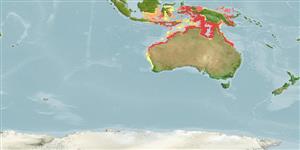Teleostei (teleosts) >
Eupercaria/misc (Various families in series Eupercaria) >
Sillaginidae (Smelt-whitings)
Etymology: Sillago: From a locality in Australia .
More on author: Richardson.
Environment: milieu / climate zone / depth range / distribution range
Ecology
Marine; demersal; oceanodromous; depth range 0 - 36 m, usually ? - 36 m (Ref. 6205). Tropical; 0°S - 35°S, 111°E - 150°E (Ref. 6205)
Western Central Pacific: Indonesia, southern New Guinea and northern Australia. Frequently confused with Sillago maculata which occurs in eastern Australia.
Length at first maturity / Size / Weight / Age
Maturity: Lm 13.4, range 13 - 13.9 cm
Max length : 36.0 cm SL male/unsexed; (Ref. 6205)
Dorsal
spines
(total): 12;
Dorsal
soft rays
(total): 19-21;
Anal
spines: 2;
Anal
soft rays: 18 - 20;
Vertebrae: 34 - 36. Swim bladder with four anterolateral extensions that are more complex than S. aeolus, but much shorter than S. maculata. Body coloration is very similar to S. maculata and S. aeolus. Body with oblique bars which are not joined as in S. maculata. The upper blotches are small, the black spot at the base of the pectoral fin is indistinct. The lateral silvery stripe is noticeable but may be quite faded.
Most abundant on silty-sand or muddy substrates. Large adults feed near gutters and sandbars inside Shark Bay and move into deeper waters of marine embayments. Juveniles frequent seaweed banks and broken bottom and occur in large numbers near mangrove creeks. They enter coastal rivers in the Swan and Mandurah estuaries in western Australia. Oviparous (Ref. 205), and are multiple spawners with synchronous development (Ref. 36823). Juveniles and adults are commonly trawled with S. robusta and S. lutea (Ref. 6205). Marketed fresh (Ref. 9679).
Life cycle and mating behavior
Maturity | Reproduction | Spawning | Eggs | Fecundity | Larvae
Multiple spawners with synchronous development (Ref. 36823).
McKay, R.J., 1992. FAO Species Catalogue. Vol. 14. Sillaginid fishes of the world (family Sillaginidae). An annotated and illustrated catalogue of the sillago, smelt or Indo-Pacific whiting species known to date. Rome: FAO. FAO Fish. Synop. 125(14):87p. (Ref. 6205)
IUCN Red List Status (Ref. 130435)
Threat to humans
Harmless
Human uses
Fisheries: minor commercial
More information
ReferencesAquacultureAquaculture profileStrainsGeneticsElectrophoresesHeritabilityDiseasesProcessingNutrientsMass conversion
Tools
Can't connect to MySQL database fbquizv2. Errorcode: Too many connections
